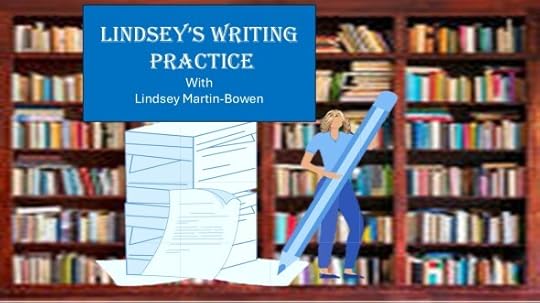LINDSEY’S WRITING PRACTICE: Punch Up Your Writing with Parallelism

Many superb professional writers—poets, playwrights, novelists, and essayists—often use parallelism to structure sentences in an eye-catching way. Note how various forms of parallelism can engage readers with its sounds, rhythms and imagery. And you can do this, too, First, examine these samples of experts using parallelism to structure sentences. (I ask students to choose two different sorts of repetition and create their own sentences using that specific repetition format—but with their own words and sentences.):
1. THE REPETITION OF KEY WORDS
A. Basal repetition—the repetition of key particles, especially prepositions and articles.
“I have a dream my four little children will one day live in a nation where they will not be judged by the color of their skin, but by the content of their character.”
—Martin Luther King, “I have a Dream”
B. Conceptual Repetition—the repetition of major conceptual terms, particularly nouns, verbs, or adjectives.
“There warn’t no color in his face, where his face showed: It was white; not like another man’s white, but a white to make a body sick, a white to make a body’s flesh crawl—a tree toad white, a fish-belly white.”
—Mark Twain, The Adventures of Huckleberry Finn
NOTE—This format is my favorite. And here’s my sentence employing Conceptual Repetition: Her eyes were deep blue: not a cornflower blue, not like a typical sunny-sky blue, but deeper than that, a blue as deep as an ocean, a blue that lured you into them—a blue that held you so tightly you couldn’t resist them.
C. Parallel Modification—using the same word to modify two different words in a sentence.
“False face must hide what the false heart doth know.”
—William Shakespeare, Macbeth
D. Isocolon—precise word-for-word repetition of two or more members (phrases, clauses, and so forth) with the exception of one or two words.
“. . . He did not know the Somali proverb that says a brave man is always frightened three times by a lion: when he first sees his track, when he first hears him roar, and when he first confronts him.”
—Ernest Hemingway, “The Short Happy Life of Frances Macomber”
2. THE USE OF OPPOSITE WORDS (ANTITHESIS)
“The rich ruleth over the poor, and the borrower is servant to the lender.”
—Proverbs 22:7 (KJV)
3. THE REPETITION OF GRAMMATICAL ELEMENTS
A. Nominal
“The hazy sunlight, the warm and drowsy air, the tender foliage, the opening flowers, betokened the reviving life of nature.”
—Mark Twain, Life on the Mississippi
B. Verbal
“Suddenly one of these gypsies, in trembling opal, seizes a cocktail out of the air, dumps it down for courage, and, moving her hands like Frisco, dances out alone on the platform.”
—F. Scott Fitzgerald, The Great Gatsby
C. Participial
“They move in orderly lines around the box, crowding one another precisely, without injury, peering down, nodding, and then backing off to let new people in.”
–Lewis Thomas, The Lives of a Cell
D. Infinitival
“Manny Greenhill is hoping to get Miss Baez to write a book, to be in a movie, and to get around to recording the rock ‘n’ roll songs.”
—Joan Didion, “Where the Kissing Never Stops”
E. Gerundive
“And with her cries came the sound of hoofs and the beating of wings and the roaring of lions.”
—Kahlil Gibran, The Prophet
F. Adjectival
“His features are strong and masculine, with an Austrian Lip, an arched Nose, his Complexion olive, his Countenance erect, his Body and Limbs well proportioned, all his Deportment majestick.”
—Jonathan Swift, Gulliver’s Travels
G. Adverbial
“The Bible’s account of Moses is, alas, as geographically perplexing as it is spiritually enlightening.”
—National Geographic
Now it’s your turn: Select at least two of these format and write a sentence emulating the form by repeating the a specific word in the format one of these writers used. Good luck—and have fun.
About Lindsey Martin-BowenOn Halloween 2023, redbat books released Lindsey Martin-Bowen’s 7th poetry collection, CASHING CHECKS with Jim Morrison. Her 4 th collection, Where Water Meets the Rock, was nominated for a Pulitzer; her 3rd, CROSSING KANSAS with Jim Morrison was a finalist in the QuillsEdge Press 2015-2016 Contest. In 2017, it won the Kansas Writers Assn award, “Looks Like a Million.” Writer’s Digest gave her “Vegetable Linguistics” an Honorable Mention in its 85th Annual (2017) Contest. Her Inside Virgil’s Garage (Chatter House Press 2013) was a runner-up in the 2015 Nelson Poetry Book Award. McClatchy Newspapers named her Standing on the Edge of the World (Woodley Press/Washburn University) was one of the Ten Top Poetry Books of 2008. It was nominated for a Pen Award.

___________________
Did you know you can sponsor your favorite blog series or even a single post with an advertisement for your book? Stop by the WtbR Sponsor Page and let me advertise your book, or you can make a donation to Writing to be Read for as little as a cup of coffee, If you’d like to show your support for this author and WordCrafter Press.
___________________
This segment of “Lindsey’s Writing Practice” is sponsored by WordCrafter Quality Writing & Author Services .

Whether it’s editing, publishing, or promotion that you need, WordCrafter Quality Writing & Author Services can help at a price you can afford.
Stop by and see what we have to offer today: https://writingtoberead.com/readings-for-writers/wordcrafter-quality-writing-author-services/
Writing to be Read
- Kaye Lynne Booth's profile
- 37 followers



